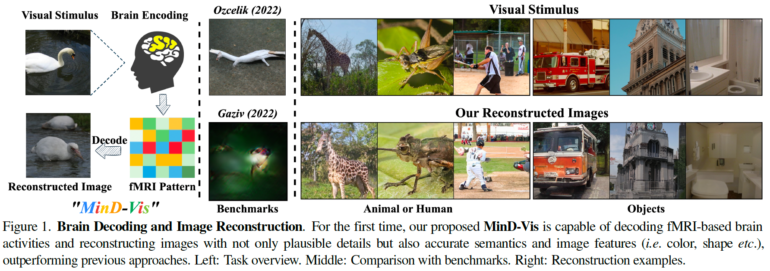TL;DR:
- Singaporean researchers introduce MinD-Vis, an AI system decoding brain wave patterns to recreate visual perceptions.
- MinD-Vis employs brain scan datasets from participants exposed to diverse images during MRI scans.
- Individual AI models are constructed to recreate visual experiences from decoded brain scans.
- Potential applications include assisting individuals with limited motor function and enhancing virtual reality experiences.
- Challenges include variations in brain anatomy and privacy concerns over unauthorized data sharing.
Main AI News:
Innovation in the realm of artificial intelligence has reached new heights with the creation of a revolutionary system known as MinD-Vis. Emerging from the laboratories of Singaporean researchers, MinD-Vis delves into the intricate world of brain wave patterns, unveiling the potential to reconstruct visual perceptions directly from the human mind. This breakthrough technology holds vast implications for both the medical field and the virtual reality domain.
At its core, MinD-Vis operates by deciphering brain scans collected from a diverse group of participants. These individuals were exposed to a spectrum of 1,200 to 5,000 distinct images, ranging from animals and food to architectural marvels and human activities, all while undergoing MRI scans. The resulting brain scan datasets became the foundation upon which MinD-Vis constructed individual AI models, allowing computers to unlock the mysteries concealed within neural pathways and recreate the vivid imagery that participants gazed upon.
Li Ruilin, one of the participants, expressed his fascination with this brain decoding endeavor, stating, “This brain decoding, like using brain signals to generate the natural modalities, is very interesting and exciting work. I’m also interested in what happened in my brain and what my brain can output and what I’m thinking.” Such enthusiasm underscores the profound nature of MinD-Vis’s capabilities.
The potential applications of MinD-Vis are far-reaching. Researchers envision its role in aiding individuals with limited motor function, offering the possibility of controlling artificial limbs through the power of thought alone. Chen Zijiao from the National University of Singapore’s School of Medicine envisions an even grander scope, suggesting that the technology could seamlessly integrate with virtual reality headsets, enabling users to navigate virtual landscapes using their minds rather than physical controllers. This marks a transformative leap in the realm of interactive experiences.
Despite its promise, MinD-Vis faces considerable challenges on its journey to full realization. Researchers acknowledge that the diversity in human brain anatomy and functionality poses a formidable obstacle. Juan Helen Zhou, an associate professor at the National University of Singapore, aptly notes, “The computational power we have, as well as the huge heterogeneity or inter-individual differences in our brain anatomy as well as brain function; this is going to be very, very difficult.” While the road ahead is challenging, the advances in gathering MRI datasets and computational capabilities have paved the way for MinD-Vis’s current success.
However, the ethical dimensions of mind-reading technology are not to be underestimated. The potential for unauthorized sharing of datasets raises concerns about privacy and consent. Zhou emphasizes the necessity of stringent guidelines and legal frameworks to safeguard individual privacy in this evolving landscape. Without such safeguards, the benefits of MinD-Vis could be overshadowed by ethical and legal dilemmas.
Conclusion:
The emergence of MinD-Vis ushers in a new era of possibilities, bridging the gap between human thoughts and tangible experiences. This breakthrough not only has significant implications for the medical field, potentially empowering those with physical limitations, but it also promises to redefine the virtual reality market. The fusion of mind and technology opens doors to novel interactive experiences, giving rise to a dynamic landscape where mental prowess takes center stage.

